英语论文引用格式
英语专业毕业论文中的引用格式

论文中的引用格式1.1 间接引用〔citations〕A.假如引用只涉及一个作家的某本专著或文章,而作家的名字在自己的行文中没有出现, 将该作家的姓氏和出版的时间用括弧括起来,放在句子结尾,注意该括弧算作句子的一局部,标点符号应放在括弧之后。
例: It has been argued that teachers’ role is to provide the students with optimal condition that can facilitate learning so that students can achieve similar results (Bloom, 1976).B.假如引用所涉及到的作家的名字已经出如今行文中, 只需要在名字后面加上括弧, 填入出版时间即可。
例:Gould (1988) attributes Darwin’s success to his gift for making the appropriate metaphor.C.假如引用涉及到的作家和著作的出版时间在行文中已出现,那就不再需要单独的夹注了。
例:In a 1988 article, Gould explores some of Darwin’s most effective metaphors.D.假如引用涉及到的著作是由两位作者合著,那么每次引用时都需把两位作者的姓氏注出来,在夹注中用“&〞,在行文中那么用“and〞连接两个作者。
例:The disadvantages of the multiple regression analysis is that it cannot show the complex interrelations between independent variable (Bryman & Cramer, 1990). Bryman and Cramer (ibid.) also pointed out that…E.如涉及到的作者超过两人,少于六人,第一次加夹注时,写出所有作者的姓氏,以后每次引用,只需写出第一作者的姓氏,其后加上“et al.〞即可。
英语论文格式与引用注释规范
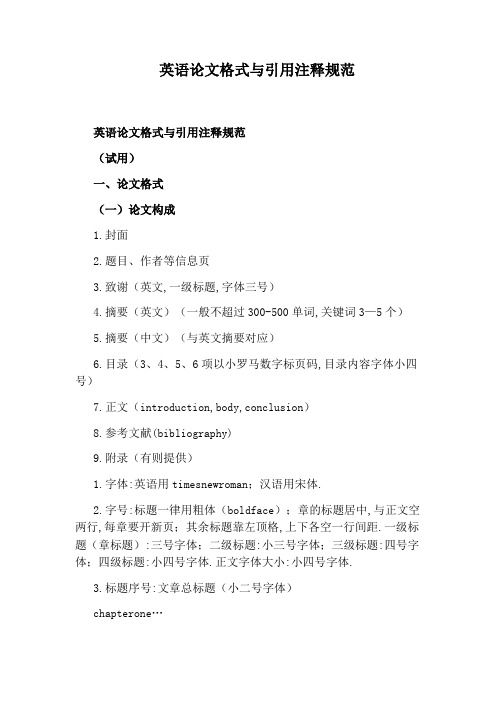
英语论文格式与引用注释规范英语论文格式与引用注释规范(试用)一、论文格式(一)论文构成1.封面2.题目、作者等信息页3.致谢(英文,一级标题,字体三号)4.摘要(英文)(一般不超过300-500单词,关键词3—5个)5.摘要(中文)(与英文摘要对应)6.目录(3、4、5、6项以小罗马数字标页码,目录内容字体小四号)7.正文(introduction,body,conclusion)8.参考文献(bibliography)9.附录(有则提供)1.字体:英语用timesnewroman;汉语用宋体.2.字号:标题一律用粗体(boldface);章的标题居中,与正文空两行,每章要开新页;其余标题靠左顶格,上下各空一行间距.一级标题(章标题):三号字体;二级标题:小三号字体;三级标题:四号字体;四级标题:小四号字体.正文字体大小:小四号字体.3.标题序号:文章总标题(小二号字体)chapterone…1.11.1.11.1.1.1…2.12.1.14.引文:少于四行的直接引文置于双引号内;超过四行(包括四行)的引文要与正文隔开,上下各空一行,左边缩进10个字母;如所引原文第一行有缩进,则该行在论文中再缩进三个字母的间距,即引文第一行缩进13个字符;字体小1号使用(即五号字体);行距为1.5.图表:图表应有与内容相符的明确标题;图的标记以第二章图一为例则为:figure2—1,依此类推;表的标记以第二章表一为例则为:table2—1,依此类推.6.行距:除四行及以上引文行距为1外,全文为1.25倍或18磅.二、引文注释规范1.注释或引用分为文内注和文末参考文献两种形式.文内注置于圆括号内,紧跟在引用内容之后;应标出作者姓(名)和页码,之间不用标点,如(bhabha120),若同一作者有多部著作引用,则应在作者姓后分别注出该著作出版年份,如,(weiss1998:76)、(weiss2002:104),等.若在文内已提供被引用者姓名,则只要将引文页码置于圆括号内.若引文文献著者有同姓者,应提供其名的首字母.若著者为多位,可在第一位著者姓之后用“等等”(etal.),也可提供所有著者姓,之间用逗号分隔.若著者为汉语姓氏,提供汉字全名,以免混淆.若引文页码有起止范围,在起止页码之间用单横线连接;若页码有两个及以上,中间用逗号分隔.若引用为间接来源,则应第一引用者姓(名)前注出“转引自”(qtd.in)字样.文内注示例:briantavessuggestssomeinterestingconclusionsregardingthe philosophyandpoliticsoftheadventurefilm(153-54,171).georgemayberry,writinginthenewrepublic,referredto itasa“deeplyandtragicallyhuman”story(108);andedwinj.lukas,inthea nnalsoftheamericanacademyofpoliticalandsocialscience,hailed itasessentialreadingforprofessionalsconcernedwiththecrimina lpersonality(216).theauthorsofwomen’swaysofknowingmakeadistinctionbetween “separateknowing”and“connectedknowing”(belenkyetal.100-30).(多位作者也可以注出所有著者姓,中间用逗号分隔.)。
英语毕业论文APA文内引用格式规范
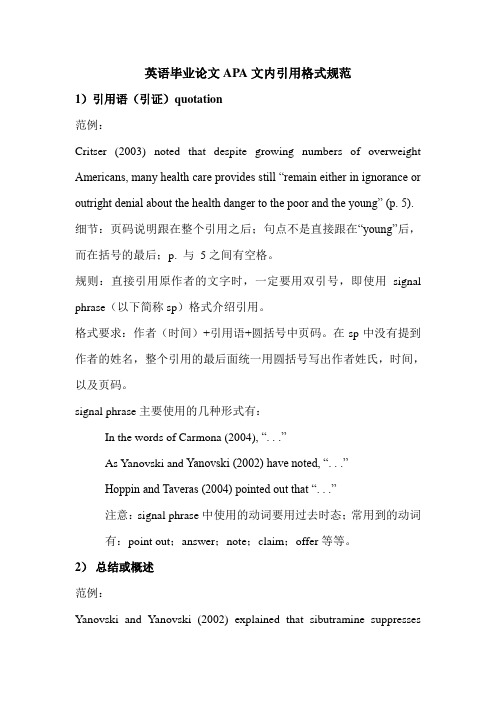
英语毕业论文APA文内引用格式规范1)引用语(引证)quotation范例:Critser (2003) noted that despite growing numbers of overweight Americans, many health care provides still “remain either in ignorance or outright denial about the health danger to the poor and the young” (p. 5).细节:页码说明跟在整个引用之后;句点不是直接跟在“young”后,而在括号的最后;p. 与5之间有空格。
规则:直接引用原作者的文字时,一定要用双引号,即使用signal phrase(以下简称sp)格式介绍引用。
格式要求:作者(时间)+引用语+圆括号中页码。
在sp中没有提到作者的姓名,整个引用的最后面统一用圆括号写出作者姓氏,时间,以及页码。
signal phrase主要使用的几种形式有:In the words of Carmona (2004), “. . .”As Yanovski and Yanovski (2002) have noted, “. . .”Hoppin and Taveras (2004) pointed out that “. . .”注意:signal phrase中使用的动词要用过去时态;常用到的动词有:point out;answer;note;claim;offer等等。
2)总结或概述范例:Yanovski and Yanovski (2002) explained that sibutramine suppressesappetite by blocking the reuptake of the neurotransmitters serotonin and norepinephrine in the brain (p. 594).或者Sibutramine suppresses appetite by blocking the reuptake of the neurotransmitters serotonin and norepinephrine in the brain (Yanovski & Yanovski, 2002, p. 594).规则:APA所需信息包括以signal phrase格式标出作者的姓氏,年份。
英语论文MLA引用格式

文中引用的格式一般情况下:(作者的姓)如果是书的话:(作者的姓引文在书中的页码)如果没有作者的话,就是(work cited里面第一个句号前的东西),因为要能够通过这个找到在work cited里的位置。
Work Cited 的格式注意标点、斜体。
注意改完之后把文中的引用提示也相应的改了。
网页引用格式:1、Name of author inverted. Full Title. Publisher, Publication date.Web. Access date.作者。
文章的标题。
发布者,发布的日期。
Web。
获取的日期(日月年)。
<网址>War Child International. Child soldiers.War Child UK, 2014. Web. 7 Apr 2014. </issues/child-soldiers>2、“Word searched.”Website Title. Created or updated date if available. Sponsoring organization of applicable. Web. Date of access written in MLA style.“搜索的关键词。
”网站的名称。
Web。
引用的日期(日月年)。
<网址>“Military use of children” Wikipedia. Web. 7 Apr2014.</wiki/Military_use_of_children#Movement_to_ stop_mili tary_use_of_children >MLA引用出版书籍引用的例子:Spangenburg, Ray and Kit Moser. Carl Sagan: A Biography. New York: Prometheus Books, 2008. Print.姓,名.书名.(斜体)出版社所在城市:出版社名称,出版时间.Print.其他引用格式介绍网址/mla-format-works-cit ed/Name of author inverted. “Article Title.”Name of Newspaper Year or date of publication: page numbers. Web. Access date.Achen, Joel. “America’s River.”Washington Post 5 May 2002. Web. 27 Feb. 2012.。
英语论文参考文献格式要求

英语专业本科毕业论文参考文献格式要求I.文内引用(一)直接引用1.引用中的省略原始资料的引用:在正文中直接引用时,应给出作者、年份,并用带括号的数字标出页码。
若有任何资料省略,使用英文时,应用3个省略号在句中标出(…),中文用6个(……);若两句间的资料省略,英文应用4个省略号标出(‥‥),中文用6个(……)。
若要在直接引用插入自己的解释,应使用方括号[ ]。
若在资料中有什么错误拼写、错误语法或标点错误会使读者糊涂,应在引用后立即插入[sic],中文用[原文如此]。
下面是一些示例:例一:The DSM IV defines the disorder [dysthymic] as being in a chronically depressed mood that occurs for "most of the day more days than not for at least two years (Criterion A) .... In children, the mood may be irritable rather than depressed, and the required minimum duration is only one year" (APA, 1994, p. 345).例二:Issac (1995) states that bipolar disorder "is not only uncommon but may be the most diagnostic entity in children and adolescents in similar settings .... and may be the most common diagnosis in adolescents who are court-remanded to such settings" (p.275).2.大段落引用当中文引用超过160字时,不使用引号,而使用“块”的形式(引用起于新的一行,首行缩进4个空格,两端对齐,之后每行都缩进)。
英文论文引用
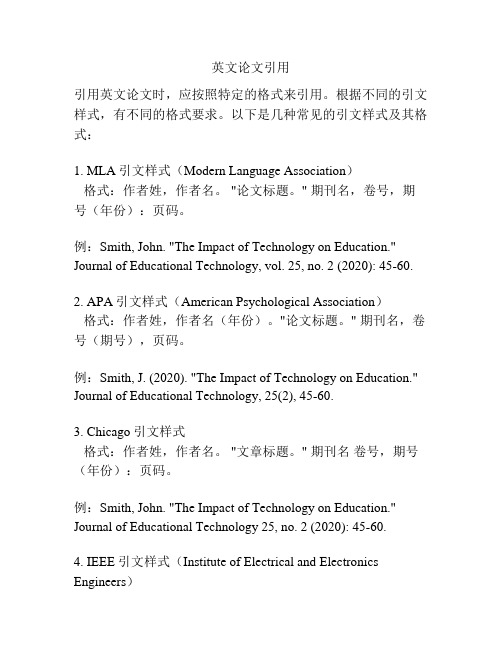
英文论文引用引用英文论文时,应按照特定的格式来引用。
根据不同的引文样式,有不同的格式要求。
以下是几种常见的引文样式及其格式:1. MLA引文样式(Modern Language Association)格式:作者姓,作者名。
"论文标题。
" 期刊名,卷号,期号(年份):页码。
例:Smith, John. "The Impact of Technology on Education." Journal of Educational Technology, vol. 25, no. 2 (2020): 45-60.2. APA引文样式(American Psychological Association)格式:作者姓,作者名(年份)。
"论文标题。
" 期刊名,卷号(期号),页码。
例:Smith, J. (2020). "The Impact of Technology on Education." Journal of Educational Technology, 25(2), 45-60.3. Chicago引文样式格式:作者姓,作者名。
"文章标题。
" 期刊名卷号,期号(年份):页码。
例:Smith, John. "The Impact of Technology on Education." Journal of Educational Technology 25, no. 2 (2020): 45-60.4. IEEE引文样式(Institute of Electrical and Electronics Engineers)格式:[数字] 作者姓,作者名,"论文标题",期刊名,卷号,期号,页码,年份。
例:[1] J. Smith, "The Impact of Technology on Education." Journal of Educational Technology, vol. 25, no. 2, pp. 45-60, 2020.请注意,不同学术领域及期刊可能会有不同的引文样式要求,因此在引用时最好查阅所写作的期刊的引文准则以确保格式的正确性。
mla英语论文引用格式要求怎么写
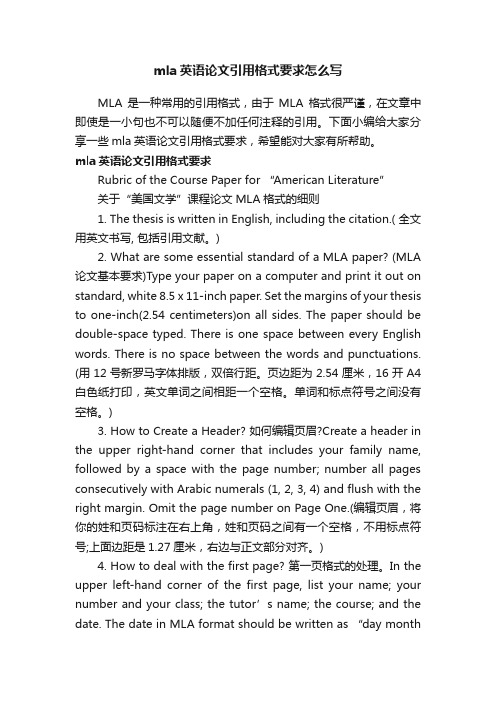
mla英语论文引用格式要求怎么写MLA 是一种常用的引用格式,由于MLA 格式很严谨,在文章中即使是一小句也不可以随便不加任何注释的引用。
下面小编给大家分享一些mla英语论文引用格式要求,希望能对大家有所帮助。
mla英语论文引用格式要求Rubric of the Course Paper for “American Literature”关于“美国文学”课程论文MLA格式的细则1. The thesis is written in English, including the citation.( 全文用英文书写, 包括引用文献。
)2. What are some essential standard of a MLA paper? (MLA 论文基本要求)Type your paper on a computer and print it out on standard, white 8.5 x 11-inch paper. Set the margins of your thesis to one-inch(2.54 centimeters)on all sides. The paper should be double-space typed. There is one space between every English words. There is no space between the words and punctuations. (用12号新罗马字体排版,双倍行距。
页边距为2.54厘米,16开A4白色纸打印,英文单词之间相距一个空格。
单词和标点符号之间没有空格。
)3. How to Create a Header? 如何编辑页眉?Create a header in the upper right-hand corner that includes your family name, followed by a space with the page number; number all pages consecutively with Arabic numerals (1, 2, 3, 4) and flush with the right margin. Omit the page number on Page One.(编辑页眉,将你的姓和页码标注在右上角,姓和页码之间有一个空格,不用标点符号;上面边距是1.27厘米,右边与正文部分对齐。
英语论文引用格式规范
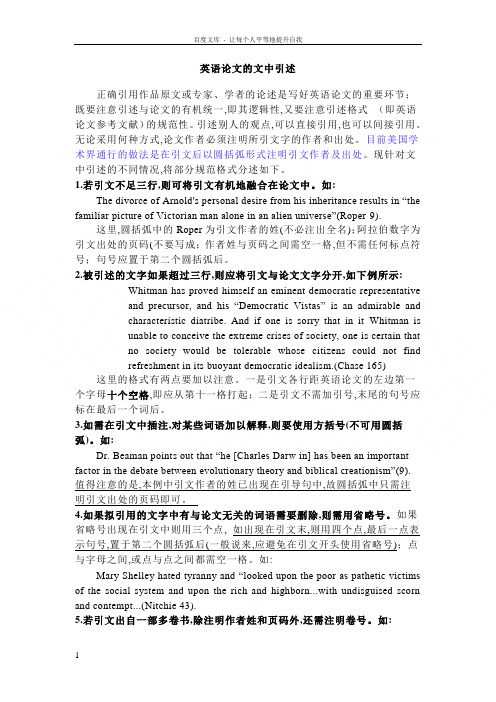
英语论文的文中引述正确引用作品原文或专家、学者的论述是写好英语论文的重要环节;既要注意引述与论文的有机统一,即其逻辑性,又要注意引述格式(即英语论文参考文献)的规范性。
引述别人的观点,可以直接引用,也可以间接引用。
无论采用何种方式,论文作者必须注明所引文字的作者和出处。
目前美国学术界通行的做法是在引文后以圆括弧形式注明引文作者及出处。
现针对文中引述的不同情况,将部分规范格式分述如下。
1.若引文不足三行,则可将引文有机地融合在论文中。
如:The divorce of Arnold's pe rsonal desire from his inheritance results in “the familiar picture of Victorian man alone in an alien universe”(Roper 9).这里,圆括弧中的Roper为引文作者的姓(不必注出全名);阿拉伯数字为引文出处的页码(不要写成;作者姓与页码之间需空一格,但不需任何标点符号;句号应置于第二个圆括弧后。
2.被引述的文字如果超过三行,则应将引文与论文文字分开,如下例所示:Whitman has proved himself an eminent democratic representativeand precursor, and his “Democratic Vistas” is an admirable andcharacteristic diatribe. And if one is sorry that in it Whitman isunable to conceive the extreme crises of society, one is certain thatno society would be tolerable whose citizens could not findrefreshment in its buoyant democratic idealism.(Chase 165) 这里的格式有两点要加以注意。
- 1、下载文档前请自行甄别文档内容的完整性,平台不提供额外的编辑、内容补充、找答案等附加服务。
- 2、"仅部分预览"的文档,不可在线预览部分如存在完整性等问题,可反馈申请退款(可完整预览的文档不适用该条件!)。
- 3、如文档侵犯您的权益,请联系客服反馈,我们会尽快为您处理(人工客服工作时间:9:00-18:30)。
四、英语论文的文中引述正确引用作品原文或专家、学者的论述是写好英语论文的重要环节;既要注意引述与论文的有机统一,即其逻辑性,又要注意引述格式(即英语论文参考文献)的规范性。
引述别人的观点,可以直接引用,也可以间接引用。
无论采用何种方式,论文作者必须注明所引文字的作者和出处。
目前美国学术界通行的做法是在引文后以圆括弧形式注明引文作者及出处。
现针对文中引述的不同情况,将部分规范格式分述如下。
1.若引文不足三行,则可将引文有机地融合在论文中。
如:The divorce of Arnold's personal desire from his inheritance results in “the familiar picture of Victorian man alone in an alien universe”(Roper9).这里,圆括弧中的Roper为引文作者的姓(不必注出全名);阿拉伯数字为引文出处的页码(不要写成p.9);作者姓与页码之间需空一格,但不需任何标点符号;句号应置于第二个圆括弧后。
2.被引述的文字如果超过三行,则应将引文与论文文字分开,如下例所示:Whitman has proved himself an eminent democratic representative and precursor, and his “Democratic Vistas”is an admirable and characteristicdiatribe. And if one is sorry that in itWhitman is unable to conceive theextreme crises of society, one is certainthat no society would be tolerable whosescitizens could not find refreshment in itsbuoyant democratic idealism.(Chase 165)这里的格式有两点要加以注意。
一是引文各行距英语论文的左边第一个字母十个空格,即应从第十一格打起;二是引文不需加引号,末尾的句号应标在最后一个词后。
3.如需在引文中插注,对某些词语加以解释,则要使用方括号(不可用圆括弧)。
如:Dr.Beaman points out that“he [Charles Darw in] has been an important factor in the debate between evolutionary theory and biblical creationism”(9).值得注意的是,本例中引文作者的姓已出现在引导句中,故圆括弧中只需注明引文出处的页码即可。
4.如果拟引用的文字中有与论文无关的词语需要删除,则需用省略号。
如果省略号出现在引文中则用三个点,如出现在引文末,则用四个点,最后一点表示句号,置于第二个圆括弧后(一般说来,应避免在引文开头使用省略号);点与字母之间,或点与点之间都需空一格。
如:Mary Shelley hated tyranny and“looked upon the poor as pathetic victims of the social system and upon the rich and highborn...with undisguised scorn and contempt...(Nitchie 43).5.若引文出自一部多卷书,除注明作者姓和页码外,还需注明卷号。
如:Professor Chen Jia's A History of English Literature aimed to give Chinese readers“a historical survey of English literature from its earliest beginnings down to the 20thcentury”(Chen,1:i).圆括弧里的1为卷号,小写罗马数字i为页码,说明引文出自第1卷序言(引言、序言、导言等多使用小写的罗马数字标明页码)。
此外,书名 A History of English Literature 下划了线;规范的格式是:书名,包括以成书形式出版的作品名(如《失乐园》)均需划线,或用斜体字;其他作品,如诗歌、散文、短篇小说等的标题则以双引号标出,如“To Autumn”及前面出现的“Democratic Vistas”等。
6.如果英语论文中引用了同一作者的两篇或两篇以上的作品,除注明引文作者及页码外,还要注明作品名。
如:Bacon condemned Platoas“an obstacle to science”(Farrington, Philosophy 35).Farrington points out that Aristotle's father Nicomachus, a physician, probably trained his son in medicine(Aristotle 15).这两个例子分别引用了Farrington的两部著作,故在各自的圆括弧中分别注出所引用的书名,以免混淆。
两部作品名均为缩写形式(如书名太长,在圆括弧中加以注明时均需使用缩写形式),其全名分别为 Founder of Scientific Philosophy 及 The Philosophy of Francis Baconand Aristotle。
7.评析诗歌常需引用原诗句,其引用格式如下例所示。
When Beowulf dives upwards through the water and reaches the surface,“The surging waves, great tra cts of water, / were all cleansed...”(1.1620-21).这里,被引用的诗句以斜线号隔开,斜线号与前后字母及标点符号间均需空一格;圆括弧中小写的1是line的缩写;21不必写成1621。
如果引用的诗句超过三行,仍需将引用的诗句与论文文字分开(参见第四项第2点内容)。
五、英语论文的文献目录论文作者在正文之后必须提供论文中全部引文的详细出版情况,即文献目录页。
美国高校一般称此页为 Works Cited, 其格式须注意下列几点:1.目录页应与正文分开,另页打印,置于正文之后。
2.目录页应视为英语论文的一页,按论文页码的顺序在其右上角标明论文作者的姓和页码;如果条目较多,不止一页,则第一页不必标出作者姓和页码(但必须计算页数),其余各页仍按顺序标明作者姓和页码。
标题Works Cited与打印纸顶端的距离约为2.5cm,与第一条目中第一行的距离仍为0.6cm;各条目之间及各行之间的距离亦为0.6cm,不必留出更多空白。
3.各条目内容顺序分别为作者姓、名、作品名、出版社名称、出版地、出版年份及起止页码等;各条目应严格按各作者姓的首字母顺序排列,但不要给各条目编码,也不必将书条与杂志、期刊等条目分列。
4.各条目第一行需顶格打印,回行时均需缩进五格,以将该条目与其他条目区分开来。
现将部分较为特殊的条目分列如下,并略加说明,供读者参考。
Two or More Books by the Same AuthorBrooks, Cleanth. Fundamentals of Good Writing: AHandbook of Modern Rhetoric. NewYork: Harcourt, 1950.---The Hidden God: Studies in Hemingway, Faulkner, Yeats,Eliot, and Warren. New Haven: Yale UP,1963.引用同一作者的多部著作,只需在第一条目中注明该作者姓名,余下各条目则以三条连字符及一句点代替该作者姓名;各条目须按书名的第一个词(冠词除外)的字母顺序排列。
An Author with an EditorShake speare, William. The Tragedy of Macbeth. Ed. Louis B.Wright. New York: Washington Square, 1959.本条目将作者 Shakespeare 的姓名排在前面,而将编者姓名(不颠倒)放在后面,表明引文出自 The Tragedy of Macbeth;如果引文出自编者写的序言、导言等,则需将编者姓名置前,如:Blackmur, Richard P.Introduction. The Art of the Novel:Critical Prefaces. By Henry James. New York: Scribner's,1962.vii-xxxix.如果引言与著作为同一人所写,则其格式如下例所示(By后只需注明作者姓即可):Emery, Donald. Preface. English Fundamentals. By Emery.London: Macmillan, 1972.v-vi.A Multivolume WorkBrowne, Thomas. The Works of Sir Thomas Browne. Ed.Geoffrey Keynes. 4 vols. London: Faber, 1928.Browne, Thomas. The Works of Sir Thomas Browne. Ed.Geoffrey Keynes. Vol.2. London: Faber, 1928. 4 vols.第一条目表明该著作共4卷,而论文作者使用了各卷内容;第二条目则表明论文作者只使用了第2卷中的内容。
A Selection from an AnthologyAbram, M. H.“English Romanticism: The Spirit of the Age.”Romanticism Reconsidered. Ed. Northrop Frye. NewYork: Columbia UP,1963.63-88.被引用的英语论文名须用引号标出,并注意将英语论文名后的句点置于引号内。
条目末尾必须注明该文在选集中的起止页码。
Articles in Journals, Magazines, and NewspapersOtto, Mary L.“Child Abuse: Group Treatment for Parents.”Personnel and Guidance Journal 62(1984): 336-48.报刊杂志名需划线,但其后不需任何标点符号。
